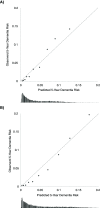Development and validation of a predictive algorithm for risk of dementia in the community setting
- PMID: 34172513
- PMCID: PMC8372383
- DOI: 10.1136/jech-2020-214797
Development and validation of a predictive algorithm for risk of dementia in the community setting
Abstract
Background: Most dementia algorithms are unsuitable for population-level assessment and planning as they are designed for use in the clinical setting. A predictive risk algorithm to estimate 5-year dementia risk in the community setting was developed.
Methods: The Dementia Population Risk Tool (DemPoRT) was derived using Ontario respondents to the Canadian Community Health Survey (survey years 2001 to 2012). Five-year incidence of physician-diagnosed dementia was ascertained by individual linkage to administrative healthcare databases and using a validated case ascertainment definition with follow-up to March 2017. Sex-specific proportional hazards regression models considering competing risk of death were developed using self-reported risk factors including information on socio-demographic characteristics, general and chronic health conditions, health behaviours and physical function.
Results: Among 75 460 respondents included in the combined derivation and validation cohorts, there were 8448 cases of incident dementia in 348 677 person-years of follow-up (5-year cumulative incidence, men: 0.044, 95% CI: 0.042 to 0.047; women: 0.057, 95% CI: 0.055 to 0.060). The final full models each include 90 df (65 main effects and 25 interactions) and 28 predictors (8 continuous). The DemPoRT algorithm is discriminating (C-statistic in validation data: men 0.83 (95% CI: 0.81 to 0.85); women 0.83 (95% CI: 0.81 to 0.85)) and well-calibrated in a wide range of subgroups including behavioural risk exposure categories, socio-demographic groups and by diabetes and hypertension status.
Conclusions: This algorithm will support the development and evaluation of population-level dementia prevention strategies, support decision-making for population health and can be used by individuals or their clinicians for individual risk assessment.
Keywords: dementia; disease modeling; epidemiology; public health.
© Author(s) (or their employer(s)) 2021. Re-use permitted under CC BY-NC. No commercial re-use. See rights and permissions. Published by BMJ.
Conflict of interest statement
Competing interests: None declared.
Figures
Similar articles
-
Dementia Population Risk Tool (DemPoRT): study protocol for a predictive algorithm assessing dementia risk in the community.BMJ Open. 2017 Oct 24;7(10):e018018. doi: 10.1136/bmjopen-2017-018018. BMJ Open. 2017. PMID: 29070641 Free PMC article.
-
Development and validation of a cardiovascular disease risk-prediction model using population health surveys: the Cardiovascular Disease Population Risk Tool (CVDPoRT).CMAJ. 2018 Jul 23;190(29):E871-E882. doi: 10.1503/cmaj.170914. CMAJ. 2018. PMID: 30037888 Free PMC article.
-
Cardiovascular Disease Population Risk Tool (CVDPoRT): predictive algorithm for assessing CVD risk in the community setting. A study protocol.BMJ Open. 2014 Oct 23;4(10):e006701. doi: 10.1136/bmjopen-2014-006701. BMJ Open. 2014. PMID: 25341454 Free PMC article.
-
Development and Validation of the Chronic Disease Population Risk Tool (CDPoRT) to Predict Incidence of Adult Chronic Disease.JAMA Netw Open. 2020 Jun 1;3(6):e204669. doi: 10.1001/jamanetworkopen.2020.4669. JAMA Netw Open. 2020. PMID: 32496565 Free PMC article.
-
Predicting Stroke Risk Based on Health Behaviours: Development of the Stroke Population Risk Tool (SPoRT).PLoS One. 2015 Dec 4;10(12):e0143342. doi: 10.1371/journal.pone.0143342. eCollection 2015. PLoS One. 2015. PMID: 26637172 Free PMC article.
Cited by
-
Evaluation of the PREDIGT score's performance in identifying newly diagnosed Parkinson's patients without motor examination.NPJ Parkinsons Dis. 2022 Jul 29;8(1):94. doi: 10.1038/s41531-022-00360-5. NPJ Parkinsons Dis. 2022. PMID: 35906250 Free PMC article.
-
What's New in Dementia Risk Prediction Modelling? An Updated Systematic Review.Dement Geriatr Cogn Dis Extra. 2024 Jun 10;14(1):49-74. doi: 10.1159/000539744. eCollection 2024 Jan-Dec. Dement Geriatr Cogn Dis Extra. 2024. PMID: 39015518 Free PMC article. Review.
-
A Health Survey-Based Prediction Equation for Incident CKD.Clin J Am Soc Nephrol. 2023 Jan 1;18(1):28-35. doi: 10.2215/CJN.0000000000000035. Clin J Am Soc Nephrol. 2023. PMID: 36720027 Free PMC article.
-
Significance of plasma p-tau217 in predicting long-term dementia risk in older community residents: Insights from machine learning approaches.Alzheimers Dement. 2024 Oct;20(10):7037-7047. doi: 10.1002/alz.14178. Epub 2024 Aug 8. Alzheimers Dement. 2024. PMID: 39115912 Free PMC article.
-
A Machine-Learning-Based Risk-Prediction Tool for HIV and Sexually Transmitted Infections Acquisition over the Next 12 Months.J Clin Med. 2022 Mar 25;11(7):1818. doi: 10.3390/jcm11071818. J Clin Med. 2022. PMID: 35407428 Free PMC article.
References
-
- Alzheimer’s Disease International . World Alzheimer Report 2018 - The State of the Art of Dementia Research: New Frontiers. London, UK, 2018.
-
- Public Health Agency of Canada . A dementia strategy for Canada: together we Aspire. Ottawa, ON, 2019.
-
- World Health Organization . Dementia: a public health priority. Geneva, Switzerland, 2012.
-
- Australian Health Ministers Advisory Council . National framework for action on dementia 2015-2019. Canberra, Australia: Deparment of Health, 2015.
Publication types
MeSH terms
Grants and funding
LinkOut - more resources
Full Text Sources
Medical
Miscellaneous

